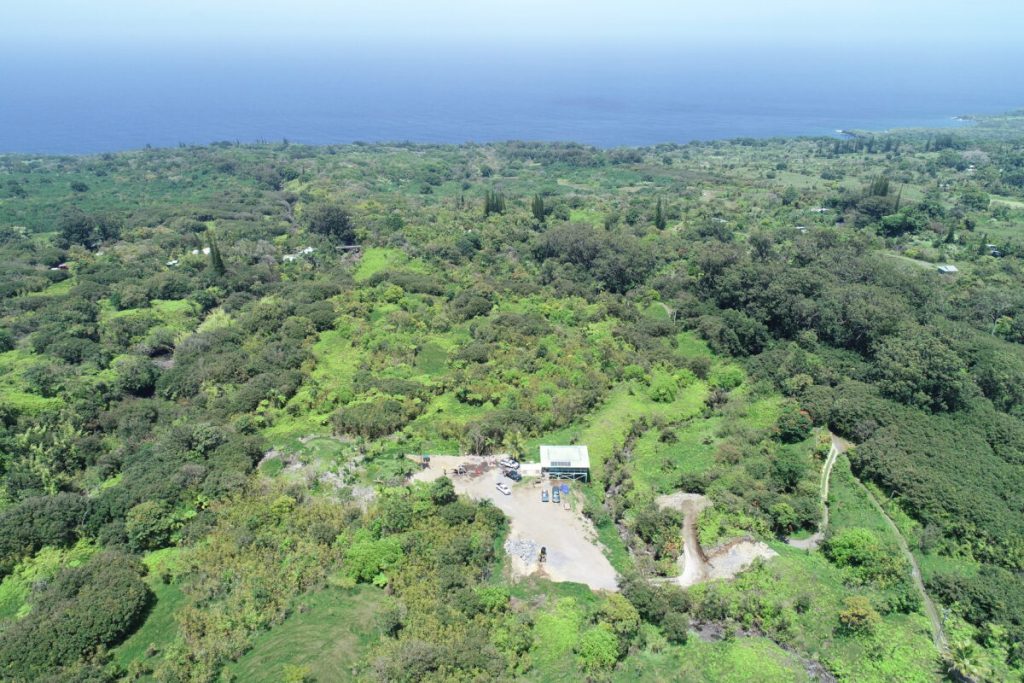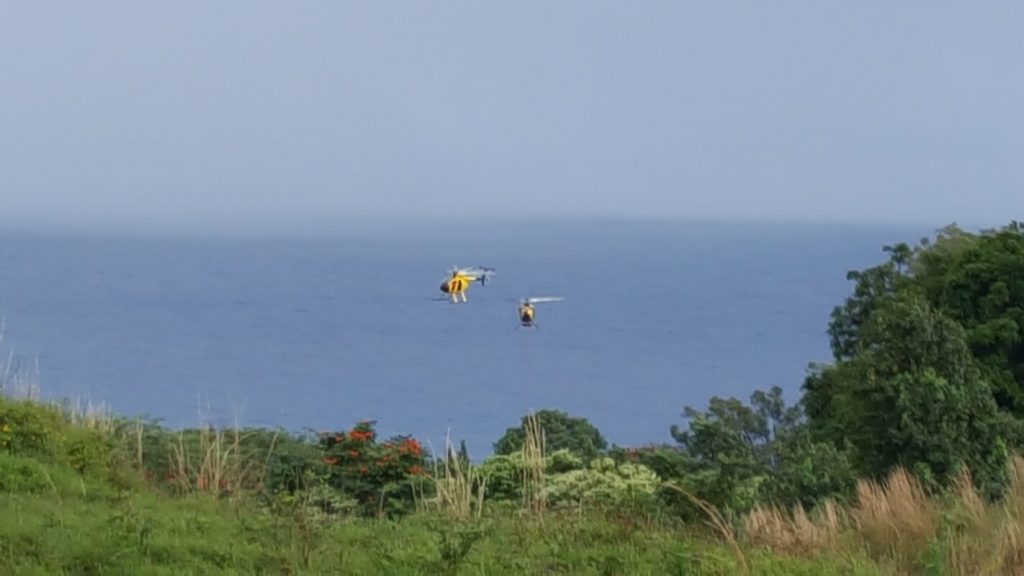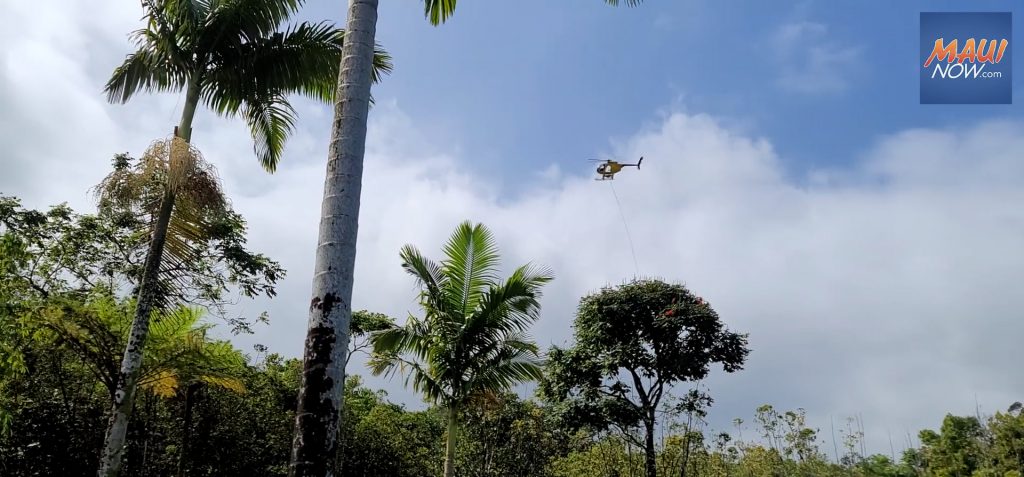A 175-acre little fire ant infestation on Maui reaches turning point
Crews with the Maui Invasive Species Committee say aerial eradication efforts of a 175-acre little fire ant infestation in Nāhiku has reached a turning point.
“We’ve reached a milestone in our efforts to get rid of the ants in Nāhiku,” said Brooke Mahnken, little fire ant coordinator with the Maui Invasive Species Committee. “We didn’t find any LFA in our last survey. This means we’re in a monitoring phase.”
Mahnken leads the efforts to eradicate little fire ants or LFA on Maui. The Nāhiku infestation, stretching nearly a mile-and-a-half long through dark tangles of plants and trees in the rainforest of East Maui, was the largest known infestation outside of Hawaiʻi Island. It appears that the ants are gone, but crews will continue to survey for five years to make sure.
Recognized as one of the 100 worst invasive species in the world, little fire ants have an unsavory reputation in Hawaiʻi, “and for good reason,” according to MISC. These undersized ants sting people in their homes, blind pets and wreck agriculture. Organization leaders say the success of one project on Maui is showing that fighting back against these devastating ants can work, even in the most challenging conditions.
“While there’s a chance LFA may turn up during future surveys, we’ve reached the point on the journey where eradication is in sight,” said Mahnken. When the MISC plant crew stumbled upon the Nāhiku infestation in 2014 while removing invasive miconia plants, MISC had neither the techniques nor the funding to attempt eradication at such a large scale.
“My heart sank because I knew how dense the vegetation was in that area. And then it got worse as we learned how big it was, that it included a criss-cross of streams, and that some landowners weren’t cooperative. If we couldn’t control this infestation, we knew it would spread to the rest of East Maui and then all of Maui,” said Teya Penniman, Interim MISC Manager. Initially, crews focused on treatments to protect residents in their homes, and around roads, vehicles and equipment to prevent accidental spread.
Mahnken said that every infestation is unique. Once a population of LFA is found (most often thanks to a report from a community member), the process of surveys and treatments begins. If the site is small and easily accessible, a little fire ant population could be eliminated in a year. Most take much longer.
Little fire ants are rainforest-adapted; they thrive in a shady, damp environment. “Nāhiku is ideal habitat for them to invade,” said Mahnken. They can form a colony in the smallest nook of a tree and colonies don’t compete with each other. Instead they form networks, eventually becoming a “supercolony,” living from the tops of trees to the leaf litter on the forest floor. Population densities can reach tens of thousands of colonies and as many as 100 million ants in an acre. To eliminate a population, every single colony must be eliminated
Little fire ants were first detected on Hawaiʻi Island in 1999, and then on Maui in 2009.
The Hilo-based Hawaiʻi Ant Lab (HAL) had begun researching effective ways to treat little fire ants, including options for getting a bait mix into the trees and shrubs. Working with HAL and the Hawaiʻi Department of Agriculture, MISC developed an effective strategy to treat the ants in Nāhiku based on previous successes. They refined the bait mixture and developed a technique to apply it using a helicopter. Funding from Maui County and the Hawaiʻi Invasive Species Council supported the project.
Five years later, in 2019, Mahnken and the team carried out the first treatment of the full infestation. A helicopter dribbled a meat-flavored bait combined with an insect growth regulator. The mixture is the consistency of pancake batter and sticks to leaves long enough for the worker ants to find it, carry it back to the colony, and feed it to the queens.
“It functions as a birth control by preventing the queens from laying eggs,” said Mahnken. Without new ants to replace the workers and queens, the colony shrinks over time and eventually disappears.
Queens have to be fed the bait regularly. It took slightly more than three years (24 treatments in total) to reach this point. Annually, crews surveyed the entire infestation, first to determine if the treatment was working and then to search for any remaining LFA. When found, the control efforts focused on areas still containing ants.
“Having an effective insecticide and a way to get it into the trees was a turning point for the State,” said Penniman, pointing to the work of HDOA and the Hawaiʻi Ant Lab. “But it also takes vision, community support, and funding,” she says. “Maui County has been a leader among the Counties in funding work on LFA. Our elected officials get it.” She calls the Nāhiku success story a “victory for us, but also the rest of the State. We have a proof of concept that it’s possible to eliminate large infestations of little fire ants in some of the most extreme habitats.”
Surveys will continue in Nāhiku. A team of over 30 crew from MISC will be joined by staff from other conservation organizations during October as they search for any straggler ants. Surveys will continue for several years. “If we find LFA on our next survey, we know we can knock out these small populations with the tools we’ve developed,” said Mahnken. “If repeat surveys over the course of five years yield no ants, we will declare the site eradicated.”
October is also “Stop the Ant” month statewide. This multi-agency effort throughout the month encourages residents to collect and submit ants from their properties to help detect and control the spread of LFA and other harmful pest ants that may be new to the state. To learn more and to participate, visit stoptheant.org.
MISC is one of five county or island-based invasive species committees working throughout Hawaiʻi to address priority invasive species. The ISCs and the Hawaiʻi Ant Lab are projects of the University of Hawaiʻi – Pacific Cooperative Studies Unit and rely on grant funding provided through the Hawaiʻi Invasive Species Council. The availability of county funding varies across the state.



















